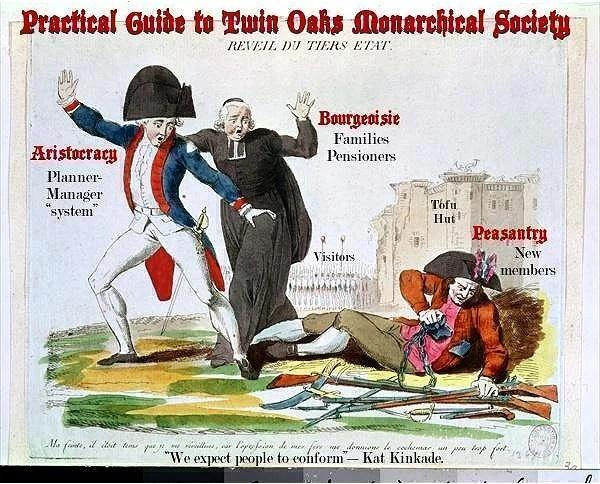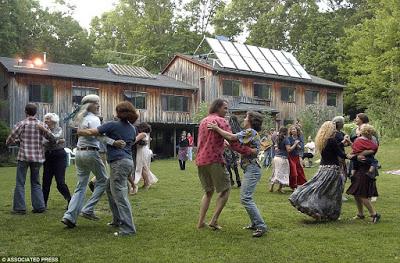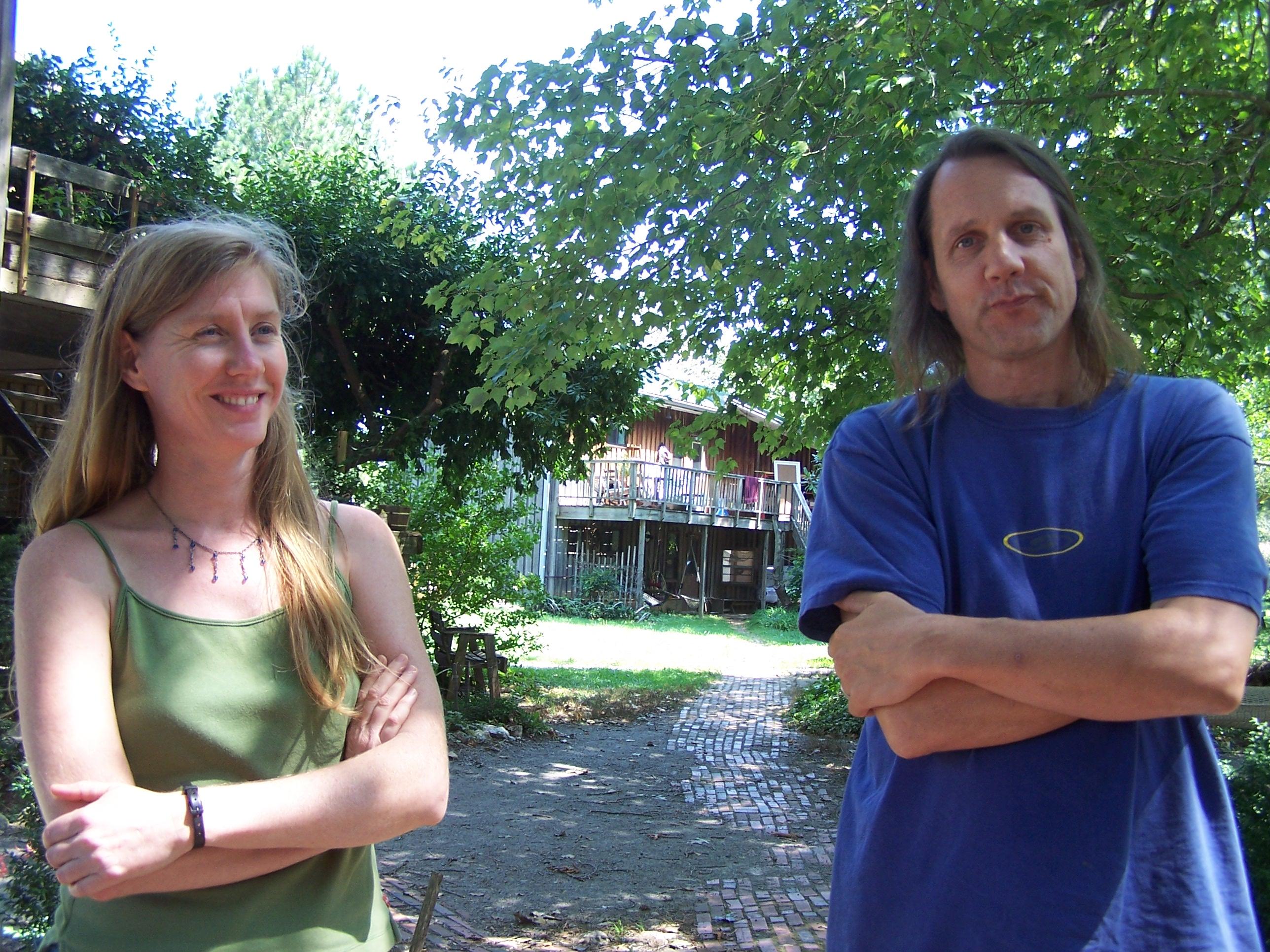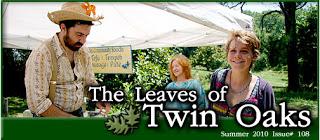Wortley Clutterbuck
Understanding Utopia
An Alternative View of Twin Oaks Community

I. Introduction
The first thing to understand about Utopia, or shall we specify Twin Oaks Intentional Community, is who is explaining it to you, and why.
Most likely, you’ve heard about Twin Oaks through a passing mention in a college course or an article in the mainstream media, then, interested, proceeded to a web search yielding up the direct page, the Wikipedia page (with all external links controlled by Twin Oaks) and any of the innumerable in-house YouTube presentations — plus the latest sales pitch, cold calls on Reddit. These narratives originate from a centralized location — the ‘recruiting’ office. Almost all information about Twin Oaks is controlled and conveyed by a select core of representatives; even when the mainstream media is the final auditor of the presentation, their journalist’s access to Twin Oaks is short, selective and supervised. This explains the unfailing regularity of the same talking heads delivering the same talking points, interspersed with the token new member exhorting the established line. The primary talking heads are not only the same people — these select speakers are the most privileged members of the aristocracy; additionally, the exhorting new members, the guileless peasantry, are ever-transient faces, usually people who leave Twin Oaks within twenty-four months of their membership. (More on that latter point to come.) This is to be expected: organizations, whether Google, North Korea or Utopia, limit and burnish their image carefully to appear in the most positive light. Like prospective members processed through the three-week visitor program, media delegates receive ‘orientation’ meetings by high-ranking members of the aristocracy, ostensibly conveying general information about Twin Oaks; in so doing, the Twin Oaks’ nobility verbally project an aura of authority, thus establishing and protecting their privileged positions.
This particular report originates from an unauthorized source. The author is Wortley Clutterbuck, a 60-year old man who lived at Twin Oaks for thirteen years. He was, by pension, a member of the bourgeoisie enjoying work stability and a self-determined schedule, possessing a few minor privileges, such as exemption from K (weekly kitchen-cleaning) shifts. He never participated in Twin Oaks’ politics, and never managed a work area; it is doubtful the aristocracy would have permit him. Although he enjoyed living at Twin Oaks, he has ideological points to critically analyze, and communicate; although he approves of the constitutionality (general values) of Twin Oaks, there are aspects of the monarchy (the government) he impugns. (To those who might inquire, ‘If you don’t like it there, why stay?’ he responds: ‘If you don’t like Trump, the Supreme Court, racist police, etc., why don’t you go to Canada?’) This dissertation is his alternative perspective — and he offers it because debunking poppycock and satirizing authority is his métier. As Charles Fourier phrased it, ‘The method of doubt must be applied to civilization; we must doubt its necessity, its excellence, and its permanence.’
Alas, power tends to protect its prerogatives. Ironically, the mandate imposing ‘nonviolent language’ becomes a tool to quash criticism of the establishment. One of the most infallible methods of determining who is an aristocrat at Twin Oaks is to publicly criticize Twin Oaks, then wait for the first round of qualifying retorts. Incredibly but almost invariably, Social Justice Warriors come to Twin Oaks eager either to submit to its rules and regulations or to apprentice for the job of law enforcement; they certainly haven’t considered it problematic that the entire aristocracy is white. As I discovered, too much questioning authority at Twin Oaks is efficaciously dissuaded, resulting in a ‘community feedback,’ a verbal mob-rule pillorying of the isolated offender (a punitive measure almost never mentioned in commune literature), or outright expulsion, either through constitutional ‘process’ or the informal hate parade of herd ostracization, screwed to perfection with contemporaneous Cancel Culture. As founder Kat Kinkade phrased it, in her memoir Is It Utopia Yet? [p. 195], “We expect people to conform.”
II. The Aristocracy
Throughout history, one of the most characteristic utopian yearnings has been the proposition that all work is equal. A staple of 19th century utopianisms, e.g. Brook Farm, it gained considerable revival with a 20th century feminist reading. In a society where everyone receives the same compensation (access to shelter, food, medical coverage, clothes and discretionary spending), the premise that all work is equal provides the basis for a claim of egalitarianism and classlessness. In actuality, whether Robert Owen’s Harmony or Bolshevik Russia, the person making such a claim is almost invariably sitting comfortably in a chair while those who attend the lofty message are expected to perform physical labor. As Ralph Waldo Emerson observed, somewhat cynically, at Brook Farm, some members ‘look out a window all day while others plough the garden’; here at Twin Oaks some members stare at Facebook all day while others … plough the garden. A bit of implication is placed on the premise that, at least within a reasonable time, all new members will have equal access to the job infrastructure, thereby the high-status positions, labor autonomy or decision-making roles at Twin Oaks; this is only at best conditionally true, and at times patently untrue. The Royal Court will decide your future and dispense your fate.

The highest stratum of Twin Oaks’ aristocracy is characterized by its monopolization of high-status positions, especially in those of management and governance. The firmest base of power resides in managerships, which have no set expiration and, although (per bylaws) technically subject to community oversight (managerial review), receive little public accountability in practice. For example, one particular garden manager presided from the Clinton administration throughout the Obama administration before deciding to retire. This is a position granting a single individual control over a huge labor force and budget, not to mention a considerable influence upon the entire community’s diet. The Visitor Program gatekeeper has held her office over two decades. And so on. As propagandist-in-chief Kat Kinkade frequently explained, deflecting intimations of power-holding, managers are ‘more exploited than workers’ because whenever something goes wrong in their area, they are held responsible; besides, they can be ‘recalled’ by community sentiment. In the first instance, although managers may certainly hear complaints, they are not obligated to heed them — chiefly because, in the second instance, they are not subject to recall by community sentiment. ‘Automatic’ managerial reviews, scheduled every five years, have not occurred in the thirteen years I lived there despite several attempted challenges to particular managerial competencies. Managerships are, for all practical purposes, private property.
This is not to suggest that managers do not necessarily work hard, long hours or conduct arduous tasks; this conception of an aristocracy at Twin Oaks eschews the trope of a leisure class wearing pearls and dining on oysters (however much recruitment travel and Facebook time may come close; and there often is a correlation between aristocrats and members with the highest VE and gift [outside income] accounts — which suggests economic determinations are made by those the least directly affected by those outcomes). The Emperor Napoleon subjected himself to more assiduous rigors than experienced by the average peasant. Nevertheless, even though a manager in charge of, say, the septic system is in charge of sewage, their aristocratic distinction lies in the being ‘in charge of,’ not the sewage. Managers often take on responsibilities many communards would eschew — repairing motors, chopping down trees, herding cattle, etc. — but, in a society where all members must perform a certain assigned amount of hours per week to maintain their membership (an average of 42), it almost invariably follows that a manager performs the work she or he desires to do; if not, these posts, which ‘pay’ no more than any other work available, are easily quit. Thus, desirability of labor, job compatibility, is a characteristic of the aristocracy, to which we add the essential quality of ‘being in charge of.’
Similarly, this is not to infer that all managerships possess equal community status or resources. Some managerships are tiny, employing a single individual and run on a small budget, such as the herb garden; some managerships, such as the hammock business, are large, employing a substantial workforce with a huge operating budget and are run by a team of aristocrats (engaging a steward for subaltern tasks). Some managerships are domestic, such as dairy, which produces only for community consumption; others are vital to the economy of Twin Oaks, such as tofu, which produces income to support all the community’s activities. Despite these significant qualitative and quantitative differences, the analogy of aristocracy applies, just as anyone familiar with the social histories of Honoré de Balzac will acknowledge that some of the titled nobility may no longer possess large estates or command great wealth or cachet at court, while others do — yet all of these nobles remain titled, above the hoi polloi. (To further deepen the analogy, this document’s use of the term monarchy denominates not a single autocrat but rather a court of cumulative powers and interests, often contradictory and shifting in import; consider the political influence of the Marquis de Lafayette or the First Duke of Talleyrand vis-à-vis Louis XVI and Marie Antoinette.) Though occasionally Twin Oaks’s monarchy experiences perceptible political dissent within its ranks (sometimes leading to cloak & dagger chicaneries), the upper echelons, whatever their differences, are always united in its need to keep the bourgeoisie sated with minor privileges and the peasantry from obtaining power.
Although managers, circumscribed by no term limits and accountable to no one but themselves, are the landed gentry of Twin Oaks, the most conspicuous members of the aristocracy are to be found in governance — the Planners, the Process Team, the Econ(omic) team, the Recruitment & Outreach office and the CMT (community membership team) in particular. Put simply, managers have power over a members’ access to labor, thereby the quota essential to membership, whereas government functionaries have power over the standard of living at any given time and the legal terms of membership itself. They interpret and enact the law (bylaws) thus — following the rudimentary blueprint of B.F. Skinner’s Walden Two, where the conception of the Planner-Manager was introduced — this elite group prevents a ‘despotism of democracy.’ An example of this principle in practice is aptly exemplified by the process in which (18-month term) Planners (the final point of Twin Oaks’ decision-making) are selected: although in very rare instances in which there are no sitting Planners, community-wide elections are conducted to fill these posts, the most frequent convention is that Planners choose other Planners, thus ensuring an ideological continuity, if not uniformity, of decision-making. This particular practice, redolent of court cronyism, greatly attenuates the idea that an 18-month term limit is much of a term limit at all. On a Republican note, this permits courtiers (and the occasional courtesan) an opportunity for advancement into the ranks of the aristocracy. To keep these flunkies on a short ideological lease, Twin Oaks traditionally applies the numerical principle of the Estates-General, which almost unfailingly insures that the incoming representative is ‘outvoted’ by the other two (senior) members. Although it is not mandatory to agree with the aristocracy on every last issue to join the aristocracy, agreeing that there should be an aristocracy is mandatory. The tactical patronage of an extensive infrastructure of courtiers and courtesans, forming a petty aristocracy, doesn’t ‘prove democracy,’ as patriots unfailingly insist — in lamentable practice, it demonstrates that peasants have a lot of buttocks expecting to be kissed.
Although all monarchical courts possess internal dissensions and intrigues (including the coup that neutralized the prestige of Kat Kinkade, the original Sovereign ), it must be acknowledged the governance at Twin Oaks enjoys considerable homogeneity due to its deplorable tradition of bundled offices among office-holders. To illustrate, it has been common (in the thirteen years I lived there), for an income-area manager to sit on the Process (legislation interpretation) Team as well as the CMT (law enforcement). Consequently, if a peasant working under a managerial purview wishes to air a grievance against that particular aristocrat, they will be forwarded to either or both the Process Team and/or the CMT, where their ‘case’ will be arbitrated by a team which includes the same person they wish to complain about; the particular aristocrat I mention is now a Planner — indeed, the central Sovereign of Twin Oaks. This example brings attention to the consuetude of a rotating, but numerically constant, elite monopolizing all the branches of government. Considering the practice of government officials often ‘electing’ each other, this bundling and rotating of offices effectively centralizes 30 legislative functions into 10. Such is the problem of aristocratic inbreeding. This freedom from the caprices of direct democracy (i.e. commoners) —where ‘a vacancy on the Board of Planners is filled by the Board from a pair of names supplied by the Managers’ — stems from Skinner’s technocratic updating of Utopia where society is bifurcated into two demographics: those with tenured degrees and those wishing to pass the exam. As it functions at Twin Oaks, community decisions are made by select elites, either in closed meetings or manipulated through an apparatus of ‘community input’ predetermined by jerrymandered algorithms — i.e. election games .

Perversely enough, none of this government high-handedness is concealed; it is simply, and naively, ignored. As the official Twin Oaks website states: “[W]e govern ourselves by a form of democracy with responsibility shared among various managers, planners, and committees” (italics added) — in other words, ‘centralized democracy’ among an upper crust. Income-sharing is not necessarily decision-sharing. What is amazing is how few prospective members ever inquire about, or challenge, the implications of living under a ‘form of’ democracy ‘shared among,’ not the entire population, but by a bureaucratic caste. So much for Social Justice. To the point of comedy, visitors frequently refuse to believe that Twin Oaks could possibly be anything but their ideological yearnings come true. But, as Ingrid Komar deduced as early as 1983’s Living the Dream [p. 104], “The simple reality is that, within the context of its many achievements, Twin Oaks is stuck in the status quo of centralized government and not ready to make the paradigm shift to decentralization” (italics added). Egalitarianism almost invariably distributes evenly somebody else’s values.
Fortunately for the sake of ‘diversity,’ Twin Oaks adds another estate to the social hierarchy: the bourgeoisie.
III. The Bourgeoisie

The primary defining characteristic of this group is seniority. Although propaganda outreach emphasizes income-sharing and the ostensible absence of honorific titles, most membership seniority is a reliable indicator of social hierarchy. Not all living quarters are created equal, nor all work spaces; indeed, a resolute exemplar of seniority is the possession of physical territory such as ‘public computers’ reserved for an individual’s work duties, control of offices or workshops, as well as the better real estate among dormitory living. The exercise of seniority is also expressed as a currency of experience — and many a supercilious peasant has been silenced with the prototypical paragraph-starter, ‘In the 20 years I’ve lived here…’ Also popular is the axiom, ‘We tried that back when, but…’ Indeed, the very command of the plural-inferring ‘we’ draws attention to an established order and its immature inverse. (Successful deployment of authority, such as seniority, benefits from the acceptance of those it is projected upon; any constant reliance upon the exercise of power demonstrates the pusillanimity of that power.)
The bourgeoisie is divided into two clearly identifiable categories, the petite and the haute.
The petite bourgeoisie are all members over the age of 50, receiving pension hours (one for every year of age 50 and above), reducing their labor quota incrementally. In this example, it is evident that, for the petite bourgeoisie, manumission from the peasantry occurs, not wholesale, but on the installment plan. (Therefore, one may consider themselves both a member of the bourgeoisie and the peasantry.) Nevertheless, pensioners are capable of augmenting this status gained from seniority by applying for various physical exemptions from onerous duties (such as tofu production which, at present, is ostensibly mandated for all community members, or all three estates), giving them a minor faux-aristocratic frisson. Pensioners are far from lottery-winners in that, theoretically, they are only free and clear of all labor quota upon turning 90 years old. Keep in mind, these people have been constitutionally compelled to surrender their Social Security checks to the common, a questionably ‘egalitarian’ sacrifice considering the Gift Policy that permits (only) fortunate individuals (most of them aristocrats) to receive surplus goodies above and beyond the common allowance.
Characterized by receiving permission to start a family, the criteria for membership in the haute bourgeoisie is considerably more selective. Upon acceptance of a pregnancy application (and unplanned pregnancies are unlawful), a couple receives, initially, maternity hours and, more significantly, childcare hours (which is nearly 20 a week per parent); this entitlement almost cuts an individual’s labor quota by half — and, incidentally, doubles their living quarters. (A pensioner has to wait 20 years to halve their respective labor quota.) Unlike pension hours, this allocation is not guaranteed, nor automatic. In order to be considered for pregnancy approval, a member (passing a mandatory two-year mark) must first undergo a parenting apprenticeship of sorts in the form of providing childcare, or nanny services, to the extant families. In this practice, the customs of aristocracy can be detected; the Child Board, who apportions or denies approval, is consistently filled with extant parents, i.e. the recipients, or customers, of nanny services. To emphasize: pregnancies and families are approved or denied by high-ranking members of the aristocracy, which requires mollifying of, identification with and acquiescence to that strata. Interestingly, childcare provides the sole instance in which the all work is equal principle is adjusted; a ‘primary’ (the supervision of one child) receives only ‘half pay’ (half labor credit). Yet the entitlement, when received, can be very satisfying for those wishing to have children; several couples at Twin Oaks presently care for two children, thus eradicating considerable labor quota — or phrased another way, they get ‘paid’ by the rest of society to raise their offspring. In addition, these particular families have pension to look forward to after their children are grown.
Relieved considerably from the constraints of labor quota, ancient pensioners and multiple-children families, the solid bourgeoisie, are relatively free from the exigencies and vagaries of labor managers, i.e. employers, thus attenuating their dependence upon the aristocracy. The history of families ‘Living the Dream’ together in community, however, has been one of internecine rivalries and conflicts worthy of Shakespeare, however passive-aggressive; only the toughest and most devious stick it out.
That said, life is even more stressful and less rewarding for the peasantry, living by the sweat of their collective brow.
IV. The Peasantry

Twin Oaks’ newest members have arrived at Utopia after surviving their evaluations as visitors; a community-wide poll — which is mediated bureaucratically by the CMT — decides if they are accepted as provisional members (a six-month stint). Thus begins public life for the peasantry — examined, appraised, scheduled and superintended. Everyone at Twin Oaks seemingly knows who they are, where they are and what they are supposed to be doing, while they know at most the aristocrats directly administering and scrutinizing them — thereby creating a psychological medium of dependence upon and deference to a judgmental hierarchy, an implication of conditional patronage. Because full membership is not assured until the provisional member passes their six-month input poll, a vote on one’s citizenship, the new arrival, predictably enough, is encouraged to adopt an ingratiatingly tractable demeanor, the perspective that will be subtly fostered as long as possible. The friendliest faces encountered are usually the most duplicitous, and hostile, or sexual / psychological predators. Beware the clipboard, the Req[uisition] and the hammock lesson.
Shortly after being deposited in one of the least desirable rooms at Twin Oaks, the new member is handed a labor sheet, a weekly schedule filled up with various tasks expected of them, and so begins the quest to ‘make quota’ (traditionally 42 labor hours a week) least they ‘fall into the labor hole’ (which imperils their membership). This dynamic presents the (aristocratic) area manager as employer and job coach and, soon enough, the new member finds themselves being offered a panoply of opportunities, most of which are repetitive, drudging, dirty tasks. A peasant may refuse any number of them, the peasant is informed benignly (as all expressions of authority are benignly presented at Twin Oaks), but the exigency to ‘make quota’ and the tactical advantage of pleasing superiors prompts obeisance. Certain fields are categorically unobtainable, such as indexing; some are conditional upon training (patronage), such as chair-making; while tasks such as tofu production are seemingly mandatory, if not inexorable. Week after week, the peasant receives a new labor sheet, filled out for them by some unseen bureaucratic hand, and week upon week, the peasant tallies their hours in the attempt to write the number 42 at the end of it.
The division of labor, requiring a reliable, uniform amount of unskilled jobs to a tiny fraction of skilled and status positions, is largely successful because so many new members ‘turn over.’ A kind of surplus labor army. Frequently a peasant’s voluntary indenturement amounts to twenty-four months, and then they depart, soon replaced by fresh recruits. Kat Kinkade explained the phenomena succinctly (without realizing or revealing its strategic demographic efficacy):
“[A]bout a quarter of our population leaves every year […] New people come to the Community, full of their own enlightenment, ambitious to see Twin Oaks reflect their ideals, and ready to commit their energies to this end. They try to make changes, and they meet resistance. Old members object to their presumption, maybe, or are simply not impressed and keep on doing things in the old ways. Some newcomers become quickly discouraged and move on to plant their vigorous enthusiasms in less stony soil.” — Kat Kinkade, Is It Utopia Yet?, 1994, pp. 166 & 170–71.
A mere four years later, Kinkade disavowed Twin Oaks entirely, telling the Washington Post [“The Other American Dream,” Nov. 15, 1998, p. W12], “I don’t think egalitarian communities are a good idea, and this one is too close to suit me. There are people here for life who mean it. I’m trapped. It’s this disappointment of, ‘Oh, life isn’t what I thought it would be’.”
The attrition rate, a defining characteristic since Day One, is significant — no less an august critic of collectivism than Ayn Rand herself cited Twin Oaks’ turnover as evidence that communitarianism proves unsuccessful — but it is singularly salient that almost all the departures occur among the peasantry. Although the current Wikipedia entry cites Twin Oaks’ turnover at 20%, within the echelons of the aristocracy and the bourgeoisie, the turnover is unvarying in the single digits ; the moribundity average of the peasantry (accounting for approximately one-third of Twin Oaks) as an estate stands around 50%, which is akin to times of war, famine or plague. Although a fifth of Twin Oaks bails annually, almost all of them peasants, their work does not — it remains objectified labor in the kitchen freezer, in the tofu plant and in the hammock warehouse for the next year’s income; thus 20% of Twin Oaks’ peasantry is silent and unseen, utterly passive. One of the classic statements made by the aristocracy to minimize the peasantry is the question, ‘Why should I listen to the opinions of someone who’s going to leave in a year or two?’; of course, this dismissive stance of superiority encourages people to leave within a year or two, thus legitimizing itself strategically. Shopping for people, then throwing them away: predictably enough, such transient culture dehumanizes civic cohesiveness.
Gerri, a long-term member with ‘no intention of leaving’ attempted to shame defectors when quoted by the Arab News (“Life in Hippie Estate Goes at a Slow Pace,” Sept. 15, 1985, p. 14): “Dreamers drift into this place and out again when they find their dreams unfulfilled. Those who wish to escape the realities of life are the ones unable to cope here because we too are realistic.” Soon after saying as much, Gerri was gone. And dozens of other righteous hard-liners before her. Although the vast majority refuse to concede as much, the reason for quitting Utopia is cogent, and simple: Socialism sucks, and perhaps that is because the high ideals of socialism almost always degenerates into the crass practices of monarchy. The more rules required, the less correct the premise. Minimal attendance for the initially ballyhooed 50th Anniversary suggests ex-members might recall their experience at Twin Oaks with attenuated enthusiasm. Patriotic platitudes about the virtuous felicities of poverty can only deny that disenchanting reality for so long — approximately, an average of twenty-four months.

Advantageously, the monthly visitor program brings another round of eager applicants from which to draw a renewed peasantry. (Ironically enough, these incoming, virginal arrivals often provide recruiting management fresh fodder for propaganda [see photo above]; the most enthusiastic votaries of Utopia are those who haven’t experienced it yet.) Almost never will a prospective member inquire why there are always vacancies open in Utopia. Few ever ask, where did all those smiling faces on the recruitment media go, and why? Communitarianism may be unsuccessful, in that peasants find the daily grind in the Tofu Hut ultimately too lacking in incentives to continue doing so, but monarchy proves quite a success, in that Twin Oaks has continued, solvent and stable, for over half a century, providing its upper crust a dependable livelihood predicated upon and supported by a continual influx of idealistic neophytes willing to subjugate themselves to what they believe, albeit temporarily, is a utopian-egalitarian program.
It is entirely probable peasant turnover will accelerate in the coming years, as the economic decisions and priorities of the current regime — for example, over-extending the capital-rapacious tofu business while tolerating the languishing hammock management — bring Twin Oaks closer to bankruptcy. Eliminating the pets budget, a historic first, is only one small indication of financial decline; divesting the Aging & Fire Fund to maintain annual solvency is a larger indication. The single gravest error of the monopolistic monarchy was the tofu expansion, harsh injurious work (nobody wants to do), necessitating an increased labor army of young, buff communards, acerbating the generational aristocracy / peasant divide. Membership diminishes as the work quota goes up and domestic budgets get cut. Twin Oaks will probably be insolvent by its 60th anniversary, in 2027, leading to terminal erosion. Best of luck, pensioners.
V. Conclusion
As history demonstrates, all egalitarian societies have been bedeviled by the lack of incentive. The flagships Brook Farm and New Harmony crumbled in less than five years; Walden Two never existed; and countless 1960s communes collapsed as the ‘Me Decade’ began. Scarcity of resources — discretionary money, standard of living, personal liberties, privacy — is frequently cited as the reason, but that is better understood as scarcity of individual incentives. Twin Oaks has survived over 50 years due to a serendipity of factors and I believe, within the circumscriptions of income-sharing and its patriotic collectivist ideology, the retention of status, in the form of a hierarchy of entitlements and exercise of political power, have contributed expressly. It is entirely likely that Twin Oaks owes much of its success to adopting, within the confines of an egalitarian regime, a model of constitutional monarchy which rewards socially-savvy senior members with ‘emoluments’ of qualitatively modest, but discernible, prestige-based class differentiation. Alas, egalitarianism, socialism, whatever-you-call-it-ism, only proves sustainable when sweetened by ostensible status.
If, in the pursuit of ideological purity, Twin Oaks adopted strict Jacobian principles, abolished its two upper estates, ‘reduced’ all inhabitants to the level of peasantry, leveled all income (that is, abolished VE and Gift accounts), and established direct democracy, managerial term limits and a rotating parliament for all official functions, I believe the abandonment rate for the entire membership would skyrocket, matching or surpassing that of the present rate for the peasantry, thus leading to the institution’s instantaneous collapse. That is what happened to the Oneida Community once its hierarchy mechanism (‘complex marriage,’ or the practice of concubinism) was removed. The principled purity of voluntarily sharing material scarcity proves difficult when practiced with strangers instead of family and loved ones; intimacy, even good will, cannot be legislated. Case in point: the several people I’ve known at Twin Oaks who inherited money immediately split (myself included).
Society, even in its most basic assemblage, engenders a will to social distinction and personal advantage; if its utopian claims of egalitarianism were as compelling as the propaganda intimates, then rarely would any of the many hundreds who lived at Twin Oaks leave Twin Oaks for the very ‘mainstream’ these many hundreds of members rejected on the way in. Do the math: If life at Twin Oaks was desirable, then its population would approach a thousand members, since at least a thousand have lived here (before voting with their feet); instead, population never exceeded a hundred at any one time, a fraction of its net residents. Like all things socialism, explaining Utopia is preferable to experiencing it; the inculcation of the explanation serves also to update indoctrination of the small core of patriots. It is not unreasonable to estimate that, of all of Twin Oaks’ members who have lived here since 1967, nine-tenths of this population subsequently departed; all the better for the one-tenth elite that remains. These are the real Twin Oakers; everyone else is migrant labor. There are more Scientologists in America than communards, so something went wrong. Initially, ‘escaping capitalism’ provides euphoria (itself suspending initial critical evaluation of the Twin Oaks experience) until it becomes evident that one has ‘escaped’ democracy, too; Twin Oaks operates on a more primitive, more coercive form of government than democracy — constitutional monarchy. (If monarchy is constitutional, it’s an intentional community; if it’s an absolute monarchy, then it’s a cult.)
While Marx posited material abundance as the prerequiste for socialism, the 20th century has suggested that abundance, being relative, is an opinion, whereas scarcity is usually perceived as a fact. The more abundance, the more democracy; who knows how much abundance leads to egalitarianism? What seems obvious, however, is that scarcity, requiring an allocation of resources, leads to hierarchy, and authority, therefore law enforcement, in philosophical contradistinction to egality. Socialism, the result of scarcity, always falls short of democracy, and certainly Utopia does as well — not ideologically, but technologically. Economic planning requires planning people, which is the opposite of freedom. Equality and inequality come from the same place — by taking something away from someone else. Denying hierarchy while depending upon it, socialism is simply monarchy with better PR. The story isn’t why people come to Utopia, but why they leave it.
Utopia, love it or leave it — what an ingenious system; peasant dissatisfaction leads not to revolution, but to demoralized evacuation, thus turning the bottom membership over to another generation of deluded rubes eager to obey and support the inexorable and interminable aristocracy and their lackeys, the bourgeoisie. It’s not a bug, it’s a feature: only when idealists get disgusted enough to depart, instead of overthrowing the Ancien Régime, does the process protect itself.
All aboard, recruits: the Tofu Hut awaits you!

Appendix: Reply from an Ex-Member
I lived at Twin Oaks for 4 years, and I know who wrote this because he made similar arguments on the O & I board (community message board) when I was living there. I don’t live in community anymore, but I still living with my partner that I met at Twin Oaks, so we talk about it often enough. Neither of us had any personal connection with this member, but we have actually referred to his metaphor of the aristocracy and peasantry when we’re reminisced about the reasons that we left Twin Oaks because in ways it feels apt. I think in this article he makes Twin Oaks sound a lot worse than it really is though. I would gladly live at Twin Oaks again, despite its “not being utopia yet.”
I wouldn’t actually call some people aristocrats and some people peasants — and in fact I served as a planner early on in my membership without any of the aristocratic benefits that he mentions — I didn’t have kids or live in a nice SLG (the dormitories). But my partner and I have talked about how there was a lot of seniority — long-term members lived in nicer housing in the “suburbs” of the community (the SLGs in the woods as opposed to the “courtyard,” where all the buildings are close together and were built the earliest. I lived in the women’s SLG which had a huge mold issue. My bedroom only had a subfloor. I used to give visitors a room tour every month and many long term members would put their rooms on the room tour, so I’d tell visitors upfront that they were going to see a lot of rooms that were nicer than the ones they’d actually live in at first. I told them I’d never seen a new member move into a room that had a bureau with all its drawers.
Long-term members tended to have better, less physical work. They could work in indexing, for example, where you read and index books in your own bedroom. The difficult jobs — like gardening and working in the tofu hut — tended to be staffed by young, short-term members. Some people would overdo it and ruin their bodies (especially in the tofu hut). So, yes, 42 hours of work is fine if you have a variety of work, but harder if you’re working in manual labor.
Also, long-term members tended to have children (which you can only have the community endorse you in having after 2 years of membership), so up to half of their work came from watching their own children, where newer members did all of their work outside of taking care of their household. My impression is that TO is a great place to raise kids, and people who want kids stick around to have them there, while people who don’t want kids seem more likely to leave. Totally a generalization though — I know many counter examples.
My impression, though, is that this is really seniority — certainly not a system of caste. People need merely stick around for 5 years and they, too, can have a nice bedroom and a cushy work situation.
Some people were asking about the process with pregnancies. You are meant to try your best not to have unplanned pregnancies. You can only apply for a pregnancy when one of the people in the couple (if it is a couple) has lived in the community for at least 2 years. But people definitely had unplanned pregnancies and were under no pressure not to have the children. Some people would be grumpy at you for not going through the correct process — but that’s about how much censure you would get. There is a material reason for this — taking care of children counts toward labor, so the more children in the community, the less labor there is for income areas.
I agree with the author’s discussion about mob rule. In my time there, undesirable members were removed through social shunning — it would get so uncomfortable for them to be there that they would voluntarily leave. Once community sentiment was against you — it was really difficult to recover, and most people didn’t. I’ve heard from current members that it’s gotten better in that regard and there is more of a push toward reintegration.
Having said all that, I really don’t think Twin Oaks is as problematic as this article suggests. Yes, social capital is a real think there. But living there was the defining moment of my life. I formed the strongest friendships I’ve ever had and I felt like I was a part of something more important than myself.
I also want to acknowledge my own biases as someone who has left Twin Oaks. My account is certainly going to be less favorable than someone’s who is still living there. I’m not committed to any of the things I just said being universal truths. They’re just my impressions.
